- Tamping method
- Vibrating mode
- The device of pillows
- Strengthening of weak ground
- Preparation of concrete
To prepare the soil before the construction, a lot of different factors should be taken into account. Particular attention should be paid to the type and composition of the soil. It can be stable (this is the best option) either weakened and unstable. In the first case, the usual concrete preparation is used, which consists in pouring a concrete cushion. This is the simplest option, in which you do not need to use complex construction equipment and expensive materials. Such preparation consists in the fact that first the sandy backfill is laid, after which a concrete mix of cement is already poured.
Scheme of "pie" of the foundation.
If the soils are weak and unstable, the soil must be strengthened. For this, preliminary tamping is carried out, reinforcement by special mixtures, which are introduced by injection methods.
Tamping method
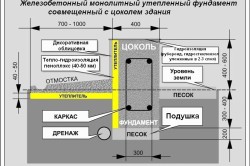
For clayey weak soils, loose sand, loess soil, the method of tamping is carried out. For this, a prepared rammer is dumped with a weight of 5 to 15 tons, the drop height is 4-8 m. The diameter of such a ramming is 1-3 m.
Heavy ramming is used when it is necessary to work with very complex soils, loose sand, clayey weak soils. The ramming can be made of steel or reinforced concrete, it has the shape of a truncated cone, the center of gravity here is quite low. All this provides the verticality of the tamper drop, the impact density.
The maximum efficiency of using this method is achieved with optimal hydration. If the soil is not moist enough, it is best to moisten it beforehand so that the working conditions are the best.
The method of tamping must necessarily take into account the number of faults. Otherwise, this method will do more harm than good. For different types of soil, the magnitude of the failure is the same:
- sandy soils - 0.05-1 cm;
- dusty clay soils - 1-2 cm.
Back to contents
Vibrating mode
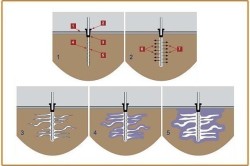
Soil compacting by injection method: 1 - concrete screed, 2 - parker, 3 - coupling, 4 - injector, 5 - nozzle of injector, 6 - place of planned fracturing, 7 - force vector for soil.
To prepare the foundation by vibrating, deep seals can be used. The process of such preparation includes the following operations:
- foundation pit preparation;
- the soil is moistened, for which a tubular perforated needle is placed in the soil. The depth of the dive is 2-2.5 m. Water is supplied through this needle.
To moisten 1 cubic meter of sand, you need to apply about 50-70 liters of water. Next to the needle, the vibrating vibro is immersed, the vibration is carried out for approximately 20-30 seconds. After the compaction is completed, the needle is removed from the ground, followed by a vibro-roll. One dipping and compaction process takes up to three minutes. All dive points should be staggered.
The use of the hydraulic vibrator makes it possible to compact the soil to a depth of 6-7 m.
For compaction with silted and clay soils, special ground and sand piles are used. The diameter of such pipes is 400-500 mm, the shoe is mounted on the end. Immersion of such pipes is carried out by a crane or coprodam.
The tip of the pipes, when immersed, compacts the soil, while its shell is filled with sand, which is layer-by-layer compacted. The pipe is removed as it is filled. This method is used to work with loess subsidence soils.
Back to contents
The device of pillows
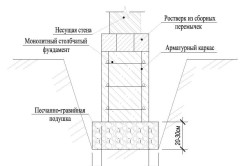
To ensure the correct load on the future foundation, it is necessary to use an embankment of sand and gravel before applying almost any method (especially for concrete pads). Apply only sifted sand or crushed stone (gravel), which is poured on a previously prepared base.
Sand is poured onto the bottom of the excavation. Its thickness, as a rule, is from 3,5 to 20 cm. Sand (or gravel) pours out to the bottom, after which it is leveled, moistened with water. The layer should not be wet, only slightly moist - this is an important condition that should not be neglected. Seal the padding is necessary with a special vibrator. After that, the surface is covered with a cement screed.
If the level of groundwater in the selected area is quite high, then the sand or gravel pours directly into the water. Its seal is made by a special deep-seated vibrator. A layer of crushed stone is poured over the top, after which the compaction is carried out using a surface vibrator or a conventional mechanical ramming.
When choosing the material, it is necessary to take only purified sand, gravel or crushed stone is recommended to use a medium fraction, homogeneous.
Back to contents
Strengthening of weak ground
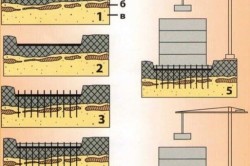
Scheme of soil reinforcement by Geocomposite method.
When building on weak and unstable soils, it is necessary to carry out reinforcement work, which includes cementation, that is, pumping of concrete mortar. Methods of such strengthening can be several:
- silicization is that after clearing the site for work, immersive special injectors are injected into the soil, injecting them through prepared solutions. After that, the injectors are removed, the wells are swabbed. For loess soils, only solutions with silicate sodium are used, which, interacting with calcium salts, are converted into a dense gel. It freezes, forming a very hard mass;
- resinization according to the principle of use is similar to silicification;
- thermal strengthening is the fixation by burning material. In this capacity, gas, some types of liquid fuel, act. The material is pumped into the well prepared in advance, the incineration is performed when the air is pumped with excess pressure;
- cementation is one of the types of concrete preparation that is used to strengthen rock fractured rocks, sandy loose, gravelly soils. At the same time, clearing and well drilling are carried out. After that special injectors are introduced into the prepared wells, through which cement mortar is pumped into the ground. Injectors after work are extracted, wells are plugged.
The difference in the quality of the foundation of houses depends not only on the materials used for the erection, but also on how the place was prepared before construction began. When building a house, it is worth deciding whether the concrete preparation for the foundation is suitable, as the most qualitative and sustainable, or for this soil it is better to choose another one. Sand or gravel preparation is less reliable, more difficult to create, but cheaper in building materials and time for laying.
Most often concrete preparation is used under a jellied foundation or to increase the strength and stability of the base of the house.
Reasons to make the base:
- Additional waterproofing, which slows the rise of moisture from the ground to the foundation.
- Smooth construction site, removes any unevenness left by digging the foundation pit with machinery or builders, allows you to even out the differences to 10 cm.
- Prevents the soaking in the soil of "concrete milk", because the concrete is poured not on the open ground, but on a solid base, the base when hardening has the same density, which increases its performance.
- It facilitates the mounting of the reinforcement, makes it possible to use locks, protecting the foundation reinforcement from corrosion.
- Eliminates the curvature of the reinforcement due to indentation into the ground under the weight of not frozen concrete.
What are the types of preparations
Preparing the site for a monolithic or strip foundation, you can choose different materials depending on the desired characteristics, the budget and the difficulty in installing yourself. The main reasons for choosing this or that option are the endurance of the soil, its humidity, whether a basement or a basement is planned. It is also important what type of support will be used, not buried, shallow or buried. From what materials, and in what way it will be erected, jellied or made of blocks, ribbon or slab.
Unfortunately, SNiP 52-01-2003 and SP 50-101-2004 do not give clear recommendations, in which case and what training to conduct, so the reason for choosing is the type of foundation and materials used for it.

Sand preparation
The simplest and cheapest way to level the ground for construction is sand preparation for the foundation, it is used quite often for light wooden houses, but it is not suitable for houses with a calculated service life of more than 10 years. It is unreliable, the gradual mixing with the soil and the germination of the roots of plants causes a subsidence under the weight of the building, there may be distortions and cracks in the floors and walls. Low moisture resistance requires additional waterproofing, to prevent dampness in the premises.
Concrete preparation
Used "lean" concrete with a maximum of 6% cement content, the main filler of which is sand, sometimes crushed stone or gravel. Pour a thin layer throughout the area of the future foundation, the thickness of concrete preparation depends on the type of soil, the weight of the house and the level of groundwater. Depending on these three factors, the thickness can be from 4 to 10 cm.
Preparation of membranes from the profile
A new method of foundation preparation, easy to install and less expensive than concrete or gravel. Despite the assurance of manufacturers of strength and similar durability, is in less demand.
If there is an opportunity, they often choose the tested substrates. Because of the additional cost of insulation, the cost can go up to the price of standard preparation.
Crushed stone preparation
Crushed stone preparation under the foundation is used if reinforcement or uneven weight distribution is not provided. Crushed stone is covered with a thickness of 15 to 20 cm, pouring it with bitumen until the formation of a film or complete impregnation of the layer. For heavy houses is unreliable due to the heterogeneity of the rubble, it can lead to distortion and cracks in the foundation and walls.
In the cold season, crushed stone is almost never used because of the difficulty of creating the right temperature for bituminous pouring.

Preliminary work before pouring the foundation
Construction of the foundation and preparation for it begins with engineering and geological work to find out how deep the groundwater is, and how much pressure the land can take on the site of the future house. A construction plan is drawn up and the type of foundation, monolithic or tape, jellied or prefabricated type, is selected.
Before creating a concrete cushion, it is necessary to make a markup of the territory in order to dig a pit. It should be able to make the formwork for pouring, so on each side of the future support, an indentation of at least 30 cm is made.
The fertile soil layer is removed and transferred to another place where it can be used. In the depth of the pit under the foundation should be a minimum of 20 cm more than the planned height of the support.
If the insulation is laid, the depth of the pit is increased by the width of the additional layers.
Method of preparation of lean concrete
Skinny concrete is called because of the very small content of cement, which because of its fragility makes it useless in full construction, but ideal for concrete preparations for the foundation. Depending on the resistance, the choice is provided by 2 classes of concrete mixes, these are B7.5 and B15, the latter is more difficult to use because of the high claydite content.
To obtain a cubic meter of a ready solution from B7.5, you need:
- 160 kg of cement, this is 6.4 bags of cement weighing 25 kg;
- 2.2 tons of sand;
- 75 liters of water.
All components should be well mixed and poured into the prepared area.
When manufacturing B15, a special technique is needed to obtain a uniform consistency of the finished mixture.
Support for monolithic slabs

On the cleaned space, 10 cm of rubble or sand is poured and compacted with a vibrating plate. This is done to remove excess moisture from the base, so it will last longer.
On the crushed stone pillow is mounted formwork, in which the concrete mass from cement B7,5 will be poured. The formwork is made of such a height that the filled concrete forms a flat top, on which the base of the house will be laid. It should be a minimum of 10 cm and a maximum of 30 cm in height.
Often when installing the formwork, the concrete preparation unit under the foundation is advised to make a margin of 10-30 cm in area relative to the foundation. This is done in order to reduce the pressure on the ground and leave room for thermal insulation and finishing works that prevent the destruction of the foundation from the side of the walls.
Fill the concrete level with the top of the formwork, level and sometimes compact with a vibration plate. For better adhesion to the jellied foundation plate, 0.8 cm diameter rods are installed in the base, protruding by 10 cm from the preparation, if the base is planned to be large, then the concrete should be poured in pieces in order to insert the connecting reinforcement.
If a ready-made concrete slab is bought, but not poured, then the rods are not installed.
After this, a layer of fine concrete is left to dry for 7-21 days, depending on the weather. Sometimes for heavy buildings, the reinforcement of the substrate is carried out with a grid with a reinforcement of 0.8 cm in cross section. In addition, the size of such a substrate should be at least 15 cm.
If the binding rods were not installed in the substrate, then it is advised to put waterproofing, heat insulation from the EPSS, and then again waterproofing on the finished flooring. After that, you can mount the formwork for pouring a monolithic base plate.
How to pour and insulate concrete preparation can be seen on the video:
Base plate for tape base
Concrete preparation for the foundation of the belt type differs from the preparation for the slab. Dig a trench, which is wider by 40 cm, on each side of the foundation ribbon. Level the bottom of the trench and lay the waterproofing. Mount the formwork at a height of 20-30 cm and pour the concrete mixture.

The width of the ribbon should be more than 15 cm on each side. If you plan to use a jellied strip foundation, the reinforcement is reinforced with rods for better grip.
When the recessed tape base is built from prefabricated blocks, it is advisable to use the preparation from gravel impregnated with a vibrating plate, impregnated with bitumen. Sometimes a waterproofing is placed on top and a second layer of concrete is poured for better resistance to damage.
If the foundation is not deep or shallow, on stable soils, it may be leveling with sand or compacted rubble without bitumen. Such a foundation, because of the lightness of the building, does not require serious strengthening.
Preparation for columnar foundation
For pile foundations, sand preparation is more often used because of the functions of the foundation itself. It is installed for light houses and on stable soils. Most often, it does not require additional amplification. If the house under construction is quite heavy, then rubble filled with bitumen is used. Concrete substrate is used extremely rarely, because of the opportunity to buy small concrete slabs, which are more reliable than poured.
Whatever the foundation and the house, in most cases, the concrete preparation will prolong the service life and, having spent the construction phase, prevent spending on a more expensive repair of the base.
Why is SNiP necessary for concrete preparation for the foundation, and what are the requirements for the builders? What are the rules and regulations? These questions arise in the mind of many masters, both beginners and experienced.
In this article we will help you understand these issues and everything is available to explain.
Photos of the preliminary basis of the base
Preparatory work for the erection of grounds
Preparation of the foundation for the house should include the following stages:
- preliminary calculations;
- preparation of the foundation site;
- preparation under the ground.
Here we will stop at the last of the listed stages. In principle, the pillow under the base is made either from rammed rubble or from lean concrete and it is easy to carry out by oneself.
Technical requirements regulate the thickness of the layer of building material, which must have concrete preparation for the foundation of the technology of work. The basic norms and requirements for the preparation of the substrate are contained in SNiP 52-01, SP 50-101-2004 and SP 52-101-2003.
The main task of this stage of the work is the preparation for the actual construction of the foundation. Existing building rules provide for different types of these works, but the main one is the concrete.
Purpose of the base for monolithic structures
- Protects the concrete mass from the flow of cement mortar. This facilitates a faster achievement of the required parameters of the base with a general improvement in its quality;
- Levels the effect of forces from the ground. The footing distributes the forces that arise in the soil;
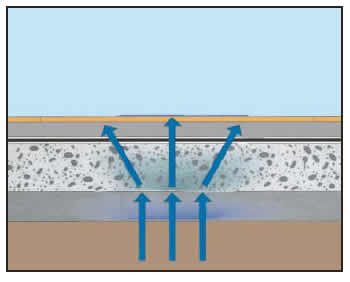
Scheme of distribution of ground forces
- Provides additional convenience for reinforcing the monolithic structure. Smooth surface facilitates work on the exact alignment of the skeleton of the base.
Types of preliminary work
The above construction rules indicate two types of base preparation:
The use of crushed stone preparations is conditioned solely by a reduction in the cost of construction (the price of rubble is generally available) and the savings in cement. The layer of rubble in this case should be 20 cm, which must be well compacted. After compaction, it is poured with bitumen.

Crushed stone before filling with bitumen
Note!
This is an unreliable method, which has a serious drawback - insufficient rigidity of the substrate.
The result of this is the impossibility of providing the maximum convenience of conducting the subsequent foundation works.
Naturally, for the construction of critical structures of this kind should be avoided. However, for auxiliary, technical or ancillary buildings, its use is entirely acceptable to reduce construction costs.
Concrete preparation
The concrete preparation for the foundation becomes urgent for the erection of reinforced belt or plate structures. The main reason is that with such technologies of erection of bases it is assumed rigid installation of steel nets and skeletons before pouring the concrete mixture.
An additional reason is connected with the fact that on a rigid surface the erection of the foundation is simplified in principle.
Important. This method is especially important in the conduct of construction work in the winter, when the soil deteriorates its properties.
The main theses, which contains instructions and rules:
- The rules allow us to use concrete M50 and above for concreting.
- The total layer thickness of 10 cm is usually enough not only to level the site, but also in order to form a solid foundation under the erected foundation.
- The layer of concrete is laid out on a pillow of sand or crushed stone.
The device of sand and crushed stone pillows
Sand preparation under the foundation provides an optimal redistribution of the load to the lower part of the base. The actuality of this is due to the fact that in the spring and autumn the soil undergoes seasonal changes.
Using a sand cushion, the lower part of the foundation can be raised above ground water level and smooth out the deforming influences of foreign objects and materials due to the obstacle to direct contact.
Council. Sand pillow makes sense to arrange, if at the bottom of the pit is a problematic soil.
In this case, the soil layer is removed and a large river sand is poured into its place with a layer of at least 150 mm.
After that, it is leveled with simple levels and is trampled with a special tool - rammer.
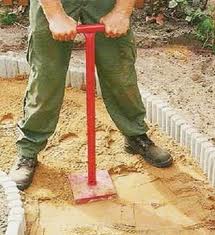
Sandblasting
A qualitative sand cushion can be laid down when taking into account the level of groundwater and seasonal changes. At a high level, it may be necessary to erect a drainage layer (which, however, will not be superfluous in any case).

Sand cushion layout
To do this, a trench is being excavated along the perimeter of the erected structure, which protects against thawed waters and increases the level of groundwater with heavy precipitation. This trench should be adequately waterproofed. Drainage will prevent the flooding of basements.
Instead of sandy, gravel preparation for the foundation can be used. It is stronger than its competitor. The material is crushed stone fraction 20/40 mm. A small layer of coarse sand (10-15 cm) is poured under a layer of crushed stone at 20-25 cm.
Crushed stone must be compacted using a plate compactor. After compaction, the upper layer of the material must be at the zero mark.

Cushion pattern using crushed stone
Important. The presence of a pillow determines the distance from the surface of the foundation to the reinforcement, which is called the protective layer.
When using a concrete cushion this layer can be reduced from the normative 7 cm in half to 3.5 cm.
Sequence of work on the concreting
- After laying the pillow, a formwork for the foundation is erected. height in the thickness of the concrete base, but not more than 30 cm;
- Folded metal rods (8-12 mm). Reinforcement will give the pillow additional strength and reliability;
- The concrete is poured;
- Deep vibrator is the final tamping of the cushion of concrete.
Important. The concrete cushion should protrude at least 15 cm over the entire area of the base.
After pouring the pillow, the pieces of reinforcement are inserted into it so that they protrude by 20-30 cm.
They must provide a cushion of cushion to the future base.
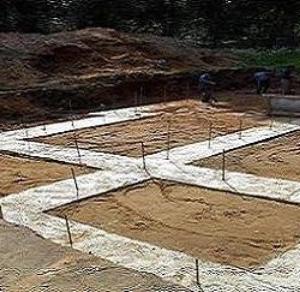
Scheme of binder reinforcement
conclusions
The current standards in construction presuppose preliminary preparation for foundations that can be executed either from rubble with bitumen or from concrete.
A concrete cushion in all respects is the optimal solution, because it not only provides better reliability of the future foundation, but also simplifies the subsequent stages of work.
In the video in this article you will find additional information on this topic.
The foundation is the foundation of any building and structure, and on how much it will be strong, the durability and strength of the entire structure will depend. Therefore, its preparation must be approached with special care. Before starting construction, it is necessary to determine exactly the type and characteristics of the soil - the foundation. The type of soil can vary significantly not only in a certain area, but even in neighboring areas. Usually when buying a site, the attached documents have similar information, but for greater confidence it is best to turn to specialists.
Preparation for the foundation - what and how
Preparation for the foundation is a set of actions necessary to ensure that the base of the foundation is as close as possible to the base of the soil, and also that the soil itself has optimal characteristics for subsequent foundation pouring.
The main action of preparation for the foundation consists of two main stages:
- soil preparation - humidification or dehumidification, if necessary, and subsequent ramming (compaction);
- preparation of excavation (cleaning the bottom of the trench).
Soil Preparation
However, first of all, we must prepare the construction site itself. It is cleared of debris and removes the fertile layer of the earth, depending on the type of soil it can be from 10 to 30 cm. This land can then be useful for equipping the garden or garden, so it is best to pour it out far away from construction work. It is necessary to remove the soil not only in the place where the foundation will be laid, but also 3-5 meters in each direction from it, because in the process of construction this part of the earth will eventually become flooded and clogged.
Preparation of soil with a weak bearing capacity - compaction
After the site has been cleared, it will be necessary to carry out the necessary preparatory work for the development of soil under the foundation. As it was already noted earlier, the ground is not the same everywhere, and accordingly the work on its preparation will vary.
In regions where the types of soils are very loose, which are not capable of making a solid base, it is necessary to compactly or semimongen the soil. The first is done by making a multilayer cushion, each layer that is rolled by heavy rollers, which pass through the same layer (place) several times. In this case, only with the use of special equipment and heavy ramming can you get the desired result.
Deep compaction can be done in two ways:
- With the use of heavy ramming.
- Vibrating or vibration-proofing with preliminary moistening.
Methods of compaction of soil
As we have already said, there are several ways to compact the soil. Let's consider each of them more specifically.
Deep compaction
The first way: foundation preparation by the method of soil tamping. Here in the role of special equipment, as it is clear from the name of the method, is a heavy ramming. The ramming can be reinforced concrete or made of carbon steel. It has the shape of a truncated cone with a strong center of gravity located in its lower part. This shape and the location of the center of gravity allows it to fall strictly vertically, which guarantees maximum saturation of the impact when falling on the ground. The weight of the rammer is from five to fifteen tons, and its standard diameter is from 1.2 to 3 meters. The heaviest tampers are used in the preparation of the foundation, where loess soils prevail, loose sands. In any other cases, the dimensions of the rammer are selected based on the depth of compaction defined by the project, the area and shape of the base being compacted.
The most effective sealing can be achieved only with ideal soil moisture. Otherwise (if the soil is too dry), it should be moistened to the required condition. The surface seal with the help of ramming is as follows. The ramp is dropped from a height of four to eight meters, again, the height of the discharge, the caliber and its weight will depend on the type of soil, the depth of compaction, the area, etc. Tramping ground occurs until the failure is visible. After the failure is noticed, it is pointless to drop the rammer again, and sometimes it is even possible to do harm. What is a failure. Failure, this is a kind of rebound of the rammer from the surface when falling. For different soils, the amount of failure can vary significantly.
The second way: preparation of soil for foundation by vibrating method. This method is used for deep compaction. Here again, all procedures will be based on the type of soil.
Let's start with sandy soils. An obligatory condition in this case is a good moistening of the soil, which occurs by immersing a tubular spire, which has small holes all over the surface of the same size, deep into the soil for two to two and a half meters. Through this spire water is supplied, while the water supply starts immediately, from the moment the plunger sinks into the ground. In order to moisturize one cubic meter of sand to the required state, it will take about seventy liters of water. Together with the spire, next, lower the vibrator head, which vibrates at a selected depth for twenty to thirty seconds. After the ground has compacted to the desired state, the spire is pulled out with the mace, but the water supply does not stop. Each process of lowering, sealing and taking out equipment takes about three minutes. Places of immersion are chosen in checkerboard order. What is needed for vibration at the time of water supply. With such shaking of the soil, its heavy particles sink, which causes the soil to be compacted. To compact the soil even deeper, for example, by 6-7 meters in depth, you will need a special technique - hydro-vibrator, which can only be moved by means of a crane.
Now about clay and silted soils. Such soil has a higher percentage of moisture than sand, and it is more viscous. Therefore, additional moistening with a perforated needle is not required here. To compact these types of soils requires other equipment: sand and soil piles. In this case, a pile with a shell made of a pipe with very thick walls is made. The diameter of such piles as a result is from 400 to 500 mm. At its end, a special shoe is carefully attached. Since it is very large, a dipper or a vibrator with a vibrator is used to immerse it. In this case, the immersion points are determined at the design level. In this case, the soil is compacted, first, due to the movement of the shoe during immersion, i.e. the tip of the pipe spreads the soil, thereby sealing it, and secondly, the lowered pile has sand in its cavity, which spills out, fills the voids and mixes with other soils, then it is also laminated in layers. As the voids fill, the pile is pulled out. Thus, the loess subsidence, clay and silted soils are compacted. The main drawback of such work is that soil compaction can occur only at a depth corresponding to the length of the pile, the lower layers are not densified. In addition, after such a deep compaction, it will also require superficial compaction.
Making a multilayer cushion under the foundation
A pillow under the foundation is needed not only to strengthen the weak soil, but also to evenly distribute the total weight of the foundation to the entire area of the soil. Material for such a pillow can be rubble or sand. The creation of a multi-layer cushion occurs as follows.
If the material was chosen rubble, then after its delivery and unloading, it is well leveled, level the surface level and moisturize. If crushed stone preparation takes place in a dry trench, its level should be 0.2 m or more, and the humidification should be more abundant. After that, it is compacted by surface vibrators.
If the pillow uses sand, the principle of its creation, in practice, does not differ from the gravel process. Sand as well after unloading is well leveled and moistened, but even in a dry pit, the sand does not have to be strongly damp. The difference in the creation of pillows in this case can arise if there is a very high level of groundwater and the material used - sand or crushed stone - simply falls and drowns in the water. Then the layers of the pillows should be thicker.
In any other cases, the number of layers should be such that after all procedures the top of the pillow is located at the same level as the projected one. After all, it is poured with cement mortar, thereby forming a cementitious screed.
Artificial fastening of weak soils
There are times when the soil is so weak that it is impossible to fix it in natural ways. In other words, neither deep, nor superficial compaction does not give the desired results. The way out of this situation is the artificial fixing of the soil.
This happens in several ways:
- silicification;
- resinization;
- thermal fixing;
- cementing.
The process of silicification is as follows. For the base is taken sodium silicate. After the area is well cleared, a solution of sodium silicate is injected under a high pressure into the special injector, after immersing the injector in the ground, also squeezing out the solution under pressure. Then the injector is removed, and the well is temporarily tightly closed. Silicate sodium is used only in places with loess soils, since the latter are very rich in calcium salts, which when combined with silicate form silicic acid, in consistency similar to gel. Then it turns into a very dense and solid mass. Silicate of sodium and phosphoric acid are used for soils from silty sands. Further, the fixing process occurs in the same way as for loess soils.
Smolization is almost the same as silicization, only a special resin is used for this. It also interacts with the soil, thanks to its sticky and viscous properties and after a while freezes.
At the heart of the method of thermal fixing lies the burning of different fuels. This can be gas or any other liquid fuel. To do this, drill the well with the depth indicated in the project and pump the fuel into it. After, under high pressure, air is pumped and fuel is burned. As a result, a column of burned soil appears under the ground. The height of such a column will depend on the length of the depth of the well, and the diameter of the amount of burned fuel and the duration of its burning, i.e. thermal exposure.
Grounding by cementation is used in areas where fractured rock rocks prevail, as well as gravel and friable sandy soils. The process of cementation is similar to the two previous processes: silicification and resinization. The surface of the site is also well cleaned, wells are drilled at a certain distance and depth, injectors are installed, cement mortar is pumped in and also squeezed out into the soil under pressure. At the end, the injector is pulled out, and the cement after a while hardens.
Thus, we examined the ways of preparing the foundation, which are used in areas where the soil has a weak bearing capacity. Now let's talk about ways of preparing the foundation in the areas where the soil is stable, has optimal humidity, etc. in such cases, as well as for low-rise construction use concrete preparation for the foundation.
Concrete preparation for foundation
The main and probably the most important advantage, which has a concrete preparation for the foundation, is its relatively low cost. Why is the cost in this case is much lower. First, such training does not require special and additional equipment, devices and chemical reagents, and secondly, time is much less spent, i.e. do not have to pay for extra hours of work.
Concrete preparation for the foundation is made in two ways: non-refractory and reinforcing.
Inerrant way less expensive, but less reliable. In this case (to save on cement) for the foundation is taken the so-called lean or rubble. Skinny is concrete, which contains only five to six percent of cement, and everything else is rubble or gravel. A grade of such concrete M100 or M200, which means not very high quality, but at the same time low cost. Crushed stone and lean concrete are laid in a layer of 20 cm, carefully compacted and filled with bituminous resin. Of course, this method of preparation is not suitable for serious buildings, but for the foundation of various auxiliary, technical and auxiliary facilities - just right.
Concrete preparation for the foundation is more reliable and is mandatory used in the construction of reinforced structures. What is it for? First, the safety of the entire building will depend on it, and secondly, it increases the resistance to groundwater erosion, especially if they are close to the surface. As a raw material for the preparation of concrete preparation for the foundation, it is recommended to use concrete only grade M50 and higher. To lay it it is necessary a layer no more than 10 see. It will suffice that it was possible to level a platform, and to create the reliable basis. In other cases, concrete preparation is poured with a relatively small layer, the thickness of which varies depending on various factors, for example, the total mass of the building, the type of soil, etc. Then the grade of concrete and the thickness of the layer will be selected based on the parameters of the project. In addition, concrete preparation under the foundation helps to prevent cement mortar from leaking out of the concrete, as this greatly reduces its quality, reduces the load force, distributing the forces that appear in the ground, and makes the fitting work more convenient, since such a flat surface allows you to do all this with the greatest accuracy.
Today, a variety of construction polymers can replace the replacement of concrete or gravel-sand preparations. Manufacturers of such materials believe that their cost is not only much lower than the prices for cement mixtures, but they are also more functional and technologically advanced.
Preparation of a pit
Preparation of the excavation begins with the cleaning of its bottom. Based on the size of its area, it can be done independently, and it is possible to attract special equipment - a bulldozer. The surface of the foundation pit is sighted and with the help of small thin sticks mark the places of crossing the line of walls. The highest place is calculated according to the level. If the soil is located above this mark, it must be cut manually. In the event that the foundation pit has a large area, the cleaning occurs mechanically, then the ground is cut below the established risk, and is covered with sand. Such work gives better results, as the contact of the surface of the foundation and the soil increases at times. If the soil is very unreliable or loose, a surface or deep seal is used, of which we spoke earlier.
